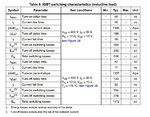Bjtpower
Full Member level 5
Hello Friends,
I went through the several threads in this Forum where i did not understood the Gate Current requirement and which driver is to be used.
I am giving you a few details here,
Application: PFC
IGBT USED:https://www.st.com/content/ccc/reso...df/jcr:content/translations/en.DM00079435.pdf
Switching Frequency:20KHZ
Gate drive voltage:15VDC
Total Gate charge from Datasheet:163nC
Now let me know How o calculate the Gate driver current requirement for same.
If traditional methods used, I=Q/T=3.26mA===> Then controller would drive the same because it provide a 20mA of current.
Pls help
Regards
Marx
I went through the several threads in this Forum where i did not understood the Gate Current requirement and which driver is to be used.
I am giving you a few details here,
Application: PFC
IGBT USED:https://www.st.com/content/ccc/reso...df/jcr:content/translations/en.DM00079435.pdf
Switching Frequency:20KHZ
Gate drive voltage:15VDC
Total Gate charge from Datasheet:163nC
Now let me know How o calculate the Gate driver current requirement for same.
If traditional methods used, I=Q/T=3.26mA===> Then controller would drive the same because it provide a 20mA of current.
Pls help
Regards
Marx
